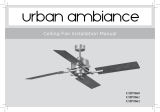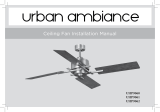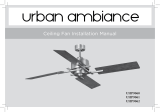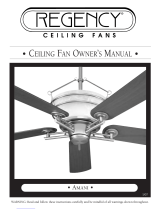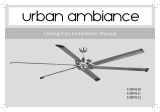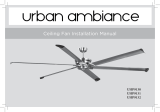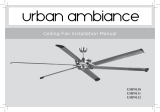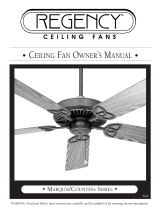
OPERATING YOUR TRANSMITTER
Your DC brushless motor is equipped with a automatically learned type
remote control. Restore power to ceiling fan and test the transmitter as below
for proper operation:
Install one 23A/12V battery (included). To prevent damage to transmitter,
remove the battery if not used for long periods of time (Fig. 10)
A. I, II, III, IV, V and VI button:
These six buttons are used to set the fan speed as follows:
I = minimum speed
II = low speed
III = medium low speed
IV = medium speed
V = medium high speed
VI = high speed
B. button:
This button turns the fan off.
C. Reverse button:
This button is to control fan direction
D. Light button
This button is to control light. Switch the “D” and “ON” dip switch on the
back of transmitter to decide the light in “ON/OFF” or “Dimmable” condition.
E. SET code setting button:
Follow the below steps to use the SET button
Step 1 Turn on the AC power for the controller after finishing the fan installation.
Step 2 Turn fan power on, press and hold SET button on the back of transmitter
for 5 seconds within 60 seconds, the transmitter learning is completed after the
light flashes twice.
Step 3 Speed setting: After setting the transmitter learning, press the highest
speed for setting the rotational speed. It will be down around 120 seconds.
Step 4 Same as step 3, reverse and press the highest speed, it will be down
around 120 seconds.
NOTE: If you want to change the blades: turn the power off change the blades
turn the power onreplay the step 2,3,4.
F. “D” and “ON” dip switch:
The “ON” selection is the light dimmable selection and is to be used with
all bulbs except for CFL bulbs. The “D” selection is the light on only (no
dimming function) and is to be used with CFL bulbs as CFL bulbs cannot
be dimmed properly.
The receiver provides the following protective function:
1. Lock position: The DC motor has a built-in safety against obstruction
during operation. The motor will be locked operation and disconnect power
after 30 seconds of interruption. Please remove obstacles before re-set.
2. Over 80W protection: When the receiver detects motor power consumption
which is greater than 80W, the receiver power will be stopped and operation
will immediately discontinue. Turn the receiver power on after 5 seconds.
10
Fig. 10
Fig. 11
ON ECE
1234
ON
D















